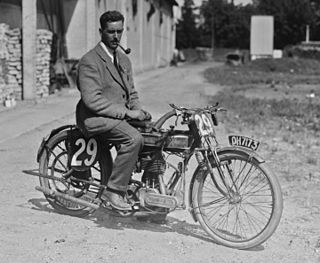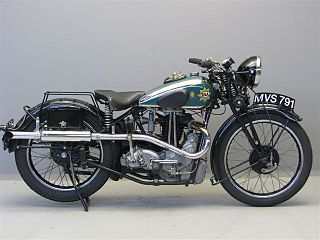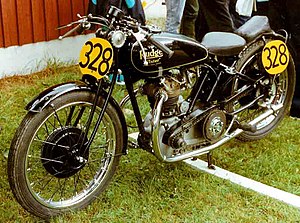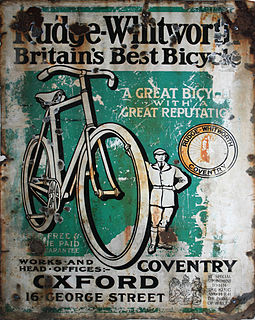
The BSA Gold Star is a motorcycle made by BSA from 1938 to 1963. They were 350 cc and 500 cc single-cylinder four-stroke production motorcycles known for being among the fastest bikes of the 1950s. Being hand built and with many optional performance modifications available, each motorcycle came from the factory with documented dynamometer test results, allowing the new owner to see the horsepower produced.
Robert Leslie (Les) Graham was a British motorcycle road racer who competed in the 1930s and 1940s. He won the inaugural Grand Prix motorcycle racing 500 cc World Championship in 1949.

Douglas was a British motorcycle manufacturer from 1907–1957 based in Kingswood, Bristol, owned by the Douglas family, and especially known for its horizontally opposed twin cylinder engined bikes and as manufacturers of speedway machines. The company also built a range of cars between 1913 and 1922.

Andrew James Guthrie was a Scottish motorcycle racer.
For the 1935 Isle of Man Tourist Trophy, Stanley Woods provided another surprise by moving again, from Husqvarna to Moto Guzzi.
Henry George Tyrell-Smith (1907–1982) was an Irish motorcycle road racer. He was born in Co Dublin and studied at Trinity College, Dublin for a B.A. And B.A.I.degree. He raced at the Isle of Man TT from 1927 to 1939, and between 1929 and 1936 competed in the German Grand Prix. He also raced in The Swedish Grand Prix in Saxtorp 1933–36.
The 1931 Isle of Man Tourist Trophy was again dominated by the battle between Rudge, Sunbeam and Norton motor-cycles.
The 1930 Isle of Man Tourist Trophy was dominated by the Rudge marque. Despite problems in practice for Rudge and the new George Hicks designed four-valve over-head valve motor-cycles the 1930 Junior TT was a closely contested race. At the end of the first lap, Charlie Dodson riding for Sunbeam led the Rudge of H. G. Tyrell Smith by only 4 seconds. On lap 2, a dead-heat was posted between Dodson and Tyrell Smith both completing the Snaefell mountain course in 1 hour, 3 minutes and 32 seconds. At Kirk Michael on lap 3, Charlie Dodson retires with valve problems, leaving Tyrell Smith to win the 7 lap race at an average speed of 71.08 mph (114.39 km/h) from Rudge team-mates Ernie Nott and Graham Walker.

Robert MacGregor McIntyre was a Scottish motorcycle racer. The first rider to clock an average speed of 100 mph (160 km/h) on the Snaefell Mountain Course, Mcintyre is also remembered for his five motorcycle Grand Prix wins which included three wins at the Isle of Man TT Races, and four victories in the North West 200. McIntyre died nine days after injuries sustained racing at Oulton Park, Cheshire in August 1962.
Dougal Marchant was an English motorcycle designer, active from the 1920s to the 1950s.

Georg "Schorsch" Meier was a German motorcycle racer famous for being the first foreign winner of the prestigious Senior TT, the Blue Riband race of the Isle of Man TT Races, in 1939 riding for the factory BMW team and the first motorcycle racer to lap a Grand Prix course at over 100 mph.

Graham William Walker was an English motorcycle racer, broadcaster and journalist. He also contributed greatly to the motorcycle section of the National Motor Museum.

The Manxman was a motorcycle designed and built by H. J. Hatch and Eric Walker of the Excelsior Motor Company in Tyseley, Birmingham. Although it never won the Isle of Man TT, the Manxman was a very popular and reliable motorcycle which was successful in international racing and the Manx Grand Prix. Production was halted by World War II and did not resume.

The Triumph Ricardo was a British single-cylinder motorcycle manufactured by the Triumph Engineering Co Ltd between 1921 and 1928. Named after engine designer Sir Harry Ricardo it featured an innovative four valve head design and was capable of over 70 mph, set three world speed records and won a gold medal in the 1923 International Six Day Trial.

The Empire Star was a standard motorcycle made by BSA at their factory in Small Heath, Birmingham. Named to commemorate the Silver Jubilee of King George V of the United Kingdom and advertised as The Masterpiece of the Industry, the Empire Star range was produced between 1936 and 1939, when it was developed into the BSA Gold Star and World War II stopped production.
Jimmy H. Simpson (1898–1981) was a British motorcycle racer.

Grindlay Peerless is a historic motorcycle manufacturer that operated out of Coventry, England, throughout the early 20th-century, specialising in racing machines including the record breaking 498cc Grindlay Peerless.

















